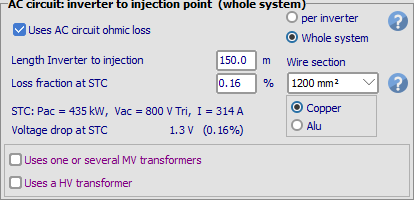|
<< Click to Display Table of Contents >> AC ohmic loss from inverter to injection point |
  
|
|
<< Click to Display Table of Contents >> AC ohmic loss from inverter to injection point |
  
|
General
The basic parameter defining the wiring losses is always the Resistance of the circuit.
For the AC circuit, this is defined by the wire length, the section and the metal. The wire length corresponds here to the distance between devices, i.e. the length of one wire per phase. The cross section is also for one wire per phase.
Almost all installations will have 3 wires (triphased). For very little monophased installations, there will be only 2 wires on the distance between the inverter and the injection point.
During the simulation, the wiring loss is calculated at each hour, as Pwloss = Rw * I².
The nominal loss fraction is defined as the ratio of the ohmic loss [kW] to a reference power, which may be either PNomPV(ac) or PNom(Inv), depending on your choice.
Remember that due to the quadratic behavior of the loss with respect to the current (or power) the loss fraction [%] is proportional to the power (or current): at half the power the loss fraction [%] will be half:
LossFrac [%] = Rw * I² / P = Rw * I² / (U * I) = Rw * I / U.
Therefore the only way to evaluate the loss fraction along the simulation is to accumulate the specific Power loss at each hour, and finally divide it by the total energy. Usually the yearly loss fraction is around 60% of the nominal Loss fraction at STC, depending namely on the meteo.
The loss fraction is not a basic parameter: it is only a convenient way of pre-defining a reasonable value of the wiring resistance, independently on the circuit power.
Injection point
The injection point is the interface between your PV plant and the grid. It is where the energy E_Grid is effectively counted for determining the sold energy financial value.
Inverter output

The AC wiring losses may simply be defined by the distance between the inverter output and the injection point (or an eventual MV transformer), and the wire section.
The program will determine the minimum section of the wires, and only propose suitable sections if you want to increase it.
Inversely you can also specify a loss fraction (at STC or PNom), and according to the chosen wire section, the corresponding wire length will appear, as well as the voltage drop for the reference power..
If several sub-arrays are defined, this AC loss may either be defined separately for each inverter (realistic wires), or globally for the whole system (virtual sum of wire sections).
With MV transformer(s): Medium Voltage line
In the same way, if you define one or several external transformer(s) you can define the properties of the MV line up to the injection point (or an eventual HV Transformer). This requires of course to also define the MV line voltage.

If there are several MV transformers, this will define the line at the output of each transformer. If the MV transformers are defined globally for the system, you should define an average length between all circuits.
With HV transformer(s): High Voltage line
Finally for very big systems, you may define a HV transformer for feeding HV grid line (> 100 kV).
Again, you have to define the grid High Voltage and the length of the line up to the injection point.
Securities with weak (remote) grids
Please note that the sizing of the cables up to the injection point may be very important when the grid is "weak" (remote grid in country regions).
When injecting power into the grid, the grid voltage will increase due to line impedance. Your inverter is equipped with a safety device, which should cut the production when exceeding a given maximum voltage. Therefore you are advised to minimize the voltage drop within your installation, at least in the parts where you have the possibility of doing this. You cannot act on the grid voltage increase due to power at the injection point: this is the responsibility of the grid manager.